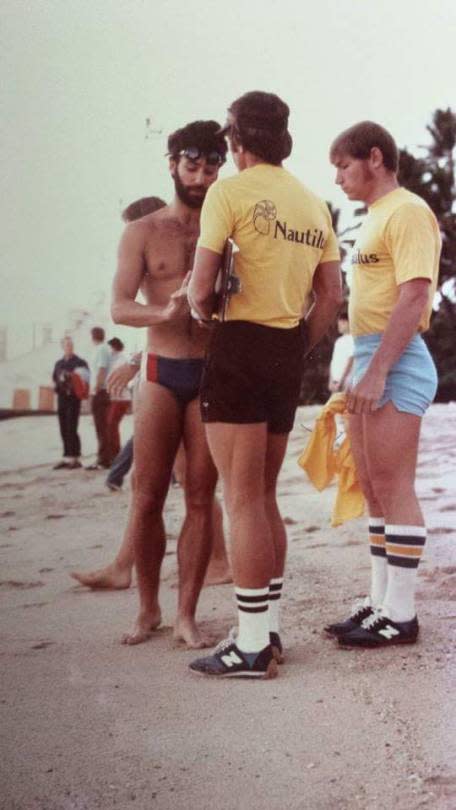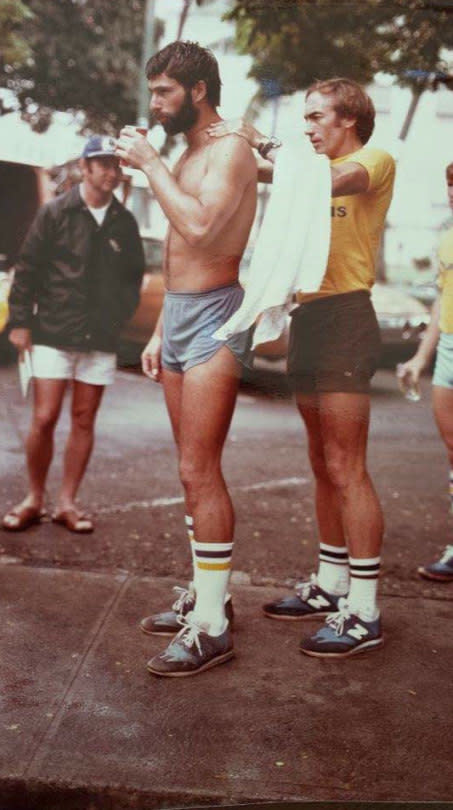What It Was Like to Win the First-Ever Ironman Triathlon

Gordon Haller, the first Ironman triathlon winner, preparing for the swim of the inaugural event in 1978. Today, Haller is still an active runner and triathlete — and the Kona Ironman World Championship has grown to a popularity he never expected. (Photo: Courtesy of Gordon Haller)
On Saturday (Oct. 10), more than 2,000 athletes will compete in the Kona Ironman World Championship in Hawaii. The 2.4-mile swim, 112-mile bike, and 26.2-mile run will be witnessed by 30,000 spectators, 5,000 volunteers, plus those tuning in to NBC’s live broadcast or the online live stream.
What is now considered the premier triathlon event, however, grew from humble beginnings back in 1978 when a group of friends decided to run the course — just “to see if we could do it,” explains 65-year-old Gordon Haller, the first Ironman winner.
In the 1970s, running was booming — especially in Hawaii. Sunday morning runs would draw “3,000 of our closest friends,” Haller tells Yahoo Health.
At the time, Haller, who was in the Navy and stationed in Hawaii, was already an accomplished marathoner, with more than 20 of the races under his belt. Because of the secret nature of his job, “I couldn’t bring work home, so I’d work an eight-hour shift and have plenty of free time to run and ride my bike,” he says.
That left him with lots of time to train. “People had been talking about who were the fittest athletes, cyclists, runners, swimmers,” Haller adds. "We thought, well, let’s just do them all.” Over a couple of months, he and a group of fellow endurance athletes plotted the course and planned the event.
On the morning of Feb. 18, 1978, Haller and 14 other athletes gathered at Waikiki Beach on the island of Oahu. Most of the people on the beach were from the local running club, Haller explains, plus one paddler to guide each athlete along the swim course.

Gordon Haller finishes the swim with his 11-year-old paddler escort during the first-ever Ironman race. (Photo: Courtesy of Gordon Haller)
“I was living with a family at the time and their 11-year-old son paddled for me,” Haller says. “Before the swim, we were both reassuring each other that we could do it.” Haller swam through the calm sea in the middle of the pack, with seven athletes ahead of him and seven behind.
Read This Next: No Legs, All Heart: Alex Zanardi Completes the Ironman at Speed
Nowadays, triathletes work for the fastest transition possible between events. Every second counts, and professional athletes practice “flying starts” to get on the bike even faster. But during the first Ironman, Haller wasn’t in such a hurry. He went to a nearby hotel to change his clothes and take a luxurious shower after the swim. After he got off the bike and before starting the marathon, he took an interview with a journalist from a local paper while receiving a shoulder massage.

Haller, in blue shorts, receives a shoulder massage during the transition from the bike to the run. (Photo: Courtesy of Gordon Haller)
Haller was a strong cyclist and an even stronger runner. When he had only five miles to go in the 140-mile event, he kicked into high gear. “I felt pretty strong the rest of the five miles, and really hammered it in,” Haller says. “It was a good day!”
Unlike the modern spectator-studded finish line — where cameras flash constantly and finishers are greeted with a booming announcement of, “You are an Ironman!” — Haller’s victory in 1978 was amusingly understated. “I crossed the line and they said, ‘Are you in the race? Well, you’re done.’”
Haller is still a competitive endurance athlete to this day, running marathons, biathlons, triathlons, and shorter running races. He often trains and races with his wife of 33 years, Beth.
Related: 8 Running Apps for Marathoners, Skeptics, and Everyone in Between
His training schedule is impressive, even for someone half his age. He swims about three times a week, runs two to three times a week, rides his bike five or six days a week, and lifts weights two to three times a week. All this while working a full-time job as a programmer analyst at Walmart’s corporate headquarters in Bentonville, Arkansas.
Haller returns to the Kona course for major milestones, and plans to race in 2018 for the Ironman’s 40th anniversary. His advice for triathletes competing this Sunday: “Stay in the moment, be aware of what’s around you, and keep moving.”
For more on the Ironman World Championship, watch the video:
Read This Next: Brandon Nabors’ 162-Pound Weight Loss: ‘Don’t Base Your Success on What Someone Else Is Doing or Looks Like’
Let’s keep in touch! Follow Yahoo Health on Facebook, Twitter, Instagram, and Pinterest.
Have a personal health story to share? We want to hear it. Tell us at YHTrueStories@yahoo.com.

